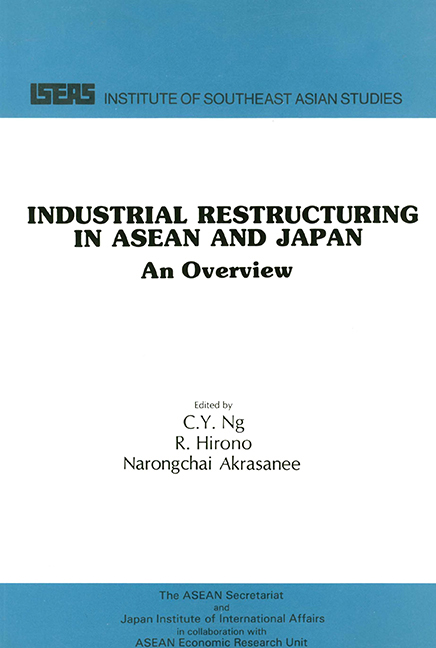Book contents
- Frontmatter
- Contents
- List of Tables
- Foreword
- Preface
- PART ONE ASEAN OVERVIEW
- PART TWO JAPAN OVERVIEW
- 1 JAPAN'S CHANGING INDUSTRIAL STRUCTURE: GROWTH AND DECLINING INDUSTRIES
- 2 CHANGING COMPARATIVE ADVANTAGES
- 3 CORPORATE RESPONSES TO INDUSTRIAL RESTRUCTURING AT HOME AND ABROAD
- 4 INDUSTRIAL RESTRUCTURING POLICY: DOMESTIC DIMENSIONS
- 5 RESTRUCTURING POLICY: INTERNATIONAL DIMENSIONS
- 6 CONCLUSIONS AND RECOMMENDATIONS
- THE EDITORS
5 - RESTRUCTURING POLICY: INTERNATIONAL DIMENSIONS
from PART TWO - JAPAN OVERVIEW
Published online by Cambridge University Press: 21 October 2015
- Frontmatter
- Contents
- List of Tables
- Foreword
- Preface
- PART ONE ASEAN OVERVIEW
- PART TWO JAPAN OVERVIEW
- 1 JAPAN'S CHANGING INDUSTRIAL STRUCTURE: GROWTH AND DECLINING INDUSTRIES
- 2 CHANGING COMPARATIVE ADVANTAGES
- 3 CORPORATE RESPONSES TO INDUSTRIAL RESTRUCTURING AT HOME AND ABROAD
- 4 INDUSTRIAL RESTRUCTURING POLICY: DOMESTIC DIMENSIONS
- 5 RESTRUCTURING POLICY: INTERNATIONAL DIMENSIONS
- 6 CONCLUSIONS AND RECOMMENDATIONS
- THE EDITORS
Summary
Changing Japanese Policies on Industrial Restructuring vis-à-vis ASEAN Countries
Japanese postures on industrial restructuring and co-operation vis-à-vis ASEAN countries have undergone significant changes over the last two decades or so. The period since 1967 when ASEAN was established can be divided into three: 1967–73; 1974–77; and 1978 and thereafter.
The Years 1967–73
While there was a steady increase in Japan's official development assistance (ODA) since 1965, especially to Southeast Asian countries, Japan did not exhibit any positive postures on economic and industrial co-operation with ASEAN. The White Paper on Economic Co-operation by the Ministry of International Trade and Industry (MITI) thus stated in 1968 that “although we recognize the necessity of expanding economic co-operation through both economic aid and trade, it is impossible to increase it rapidly because it entails a large financial burden and adverse effects on domestic related industries”.
Japan's position, however, underwent a gradual change in line with the continued expansion and upgrading of the national economy. A phrase “international division of labour” appeared for the first time in the 1969 White Paper, which considered it to be fundamentally desirable that an international division of labour between Japan and Southeast Asian countries could be realized for the long-term development of the Japanese economy and Southeast Asian countries. Japan's positive view toward the international division of labour was reinforced in the 1970s. The 1970 and 1971 White Papers were sub-titled respectively as “The Necessity for International Division of Labour” and “Promotion of Rational Division of Labour”.
The Years 1974–77
The energy crisis in October 1973 had a significant impact and revelation on the Japanese posture on an international division of labour. Japan was one of the industrial countries most adversely affected by the energy crisis. The rapidly increasing Japanese direct investment overseas since 1972 especially in developing countries therefore reflected a growing concern with the secure supply of energy and other natural resources for domestic industries.
- Type
- Chapter
- Information
- Industrial Restructuring in ASEAN and JapanAn Overview, pp. 103 - 108Publisher: ISEAS–Yusof Ishak InstitutePrint publication year: 1987

